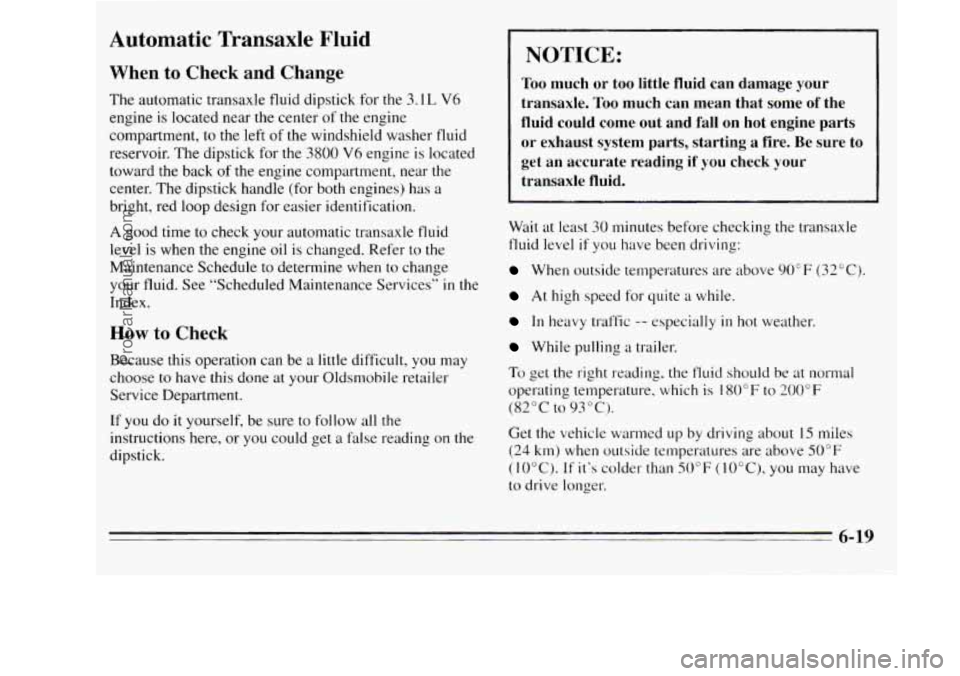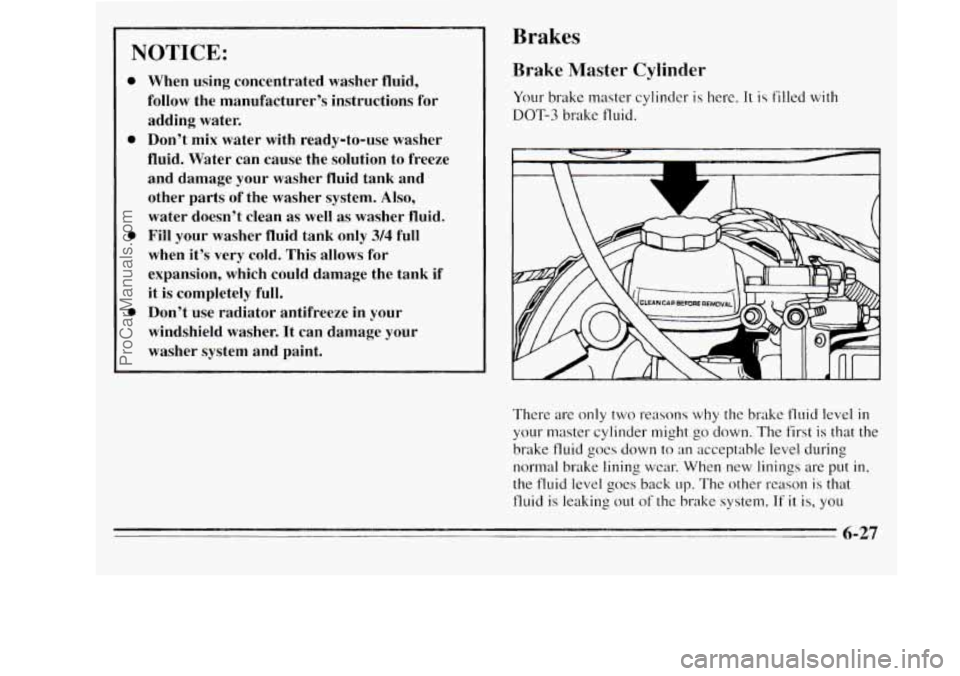Page 113 of 390

Windshield Washer
To wash your windshield, press and hold the windshield
washer switch. The washers and wipers will operate.
When you release the switch, the washers will ‘stop, and
the wipers will continue to operate for two cycles, unless
your wipers had already been
on. In that case, the wipers
will resume the wiper speed you had selected earlier. Driving without
washer fluid can be dangerous.
A bad mud
splash can block your vision. You could
hit another vehicle
or go off the road. Check your washer fluid level often.
NOTICE:
When using concentrated washer fluid, follow
the manufacturer’s instructions for adding
water. Don’t
mix water with ready-to-use
washer fluid. Water can cause the solution to
freeze and damage your washer fluid
tank and
other parts of the washer system.
Also, water
doesn’t clean
as well as washer fluid.
Fill your washer fluid tank only 3/4 full when
it’s very cold.
This allows for expansion, which
could damage the tank
if it is completely full.
windshield washer.
It can damage your paint.
Don’t use radiator antifreeze in your
2-43
ProCarManuals.com
Page 207 of 390

Include an ice scraper, a small brush or broom, a supply
of windshield washer fluid, a rag, some winter outer
clothing, a small shovel,
a flashlight, a red cloth, and a
couple of reflective warning triangles. And, if you will
be driving under severe conditions, include a small bag
of sand, a piece
of old carpet or a couple of burlap bags
to help provide traction. Be sure you properly secure
these items in your vehicle.
Driving on Snow or Ice
Most of the time, those places where your tires meet the
road probably have good traction.
However,
if there is snow or ice between your tires and
the road, you can have
a very slippery situation. You’ll
have a lot less traction or “grip” and will need to be very
careful.
What’s the worst time for this? “Wet ice.” Very cold
snow or ice can be slick and hard to drive on. But wet
ice can be even more trouble because it may offer the
least traction of all. You can get “wet ice” when it’s
about freezing
(32 OF; 0” C) and freezing rain begins to
fall. Try
to avoid driving on wet ice until salt and sand
crews can get there.
4-25
ProCarManuals.com
Page 269 of 390
3.1L V6 Engine
1. Engine Coolant Reservoir
2. Power Steering Fluid Reservoir
3. Air Cleaner
4. Brake Fluid Reservoir
5. Windshield Washer Fluid Reservoir
6. Battery
7. Automatic Transaxle Fluid Dipstick
8. Engine Oil Dipstick
9. Engine Oil Fill Cap
IO. Radiator Cap
6-9
ProCarManuals.com
Page 270 of 390
P
3800 V6 Engine
1. Engine Coolant Reservoir 6. Battery
2. Power Steering Fluid Reservoir 7. Air Cleaner
3. Automatic Transaxle Fluid Dipstick 8. Engine Oil Dipstick
4. Brake Fluid Reservoir 9. Engine Oil Fill Cap
5. Windshield Washer Fluid Reservoir 10. Radiator Cap
6-10
ProCarManuals.com
Page 277 of 390
Air Cleaner
The air cleaner for the 3.1L V6 engine is circular in
shape and is located toward the back of the engine
compartment, near the center.
The air cleaner for the 3800 V6 engine is located at the
front
of the engine compartment (on the driver’s side of
the vehicle), to the left of the windshield washer fluid
reservoir.
Refer to the Maintenance Schedule
to determine when to
replace the air filter and the crankcase ventilation filter.
See “Scheduled Maintenance Services’’
in the Index.
I NOTICE:
If the air cleaner is off, a backfire can cause a
damaging engine fire. And, dirt can easily get into your engine, which
will damage it. Always
have the air cleaner in place when you’re driving.
ProCarManuals.com
Page 279 of 390

Automatic Transaxle Fluid
When to Check and Change
The automatic transaxle fluid dipstick for the 3.1 L V6
engine is located near the center of the engine
compartment, to the left
of the windshield washer fluid
reservoir. The dipstick for
the 3800 V6 engine is located
toward the back
of the engine Compartment, near the
center. The dipstick handle (for both engines) has
a
bright, red loop design for easier identification.
A good time to check your automatic transaxle fluid
level is when the engine oil is changed. Refer to the
Maintenance Schedule to determine when to change
your fluid. See “Scheduled Maintenance Services”
in the
Index.
How to Check
Because this operation can be a little difficult, you may
choose to have this done at your Oldsmobile retailer
Service Department.
If
you do it yourself, be sure to follow all the
instructions here, or
you could get a false reading on the
dipstick.
NOTICE:
Too much or too little fluid can damage your
transaxle.
Too much can mean that some of the
fluid could come out and fall on hot engine parts
or exhaust system parts, starting a fire. Be sure to
get
an accurate reading if you check your
transaxle fluid.
Wait at least 30 minutes before checking the transaxle
fluid level
if you have been driving:
When outside temperatures are above 90°F (32°C).
At high speed for quite a while.
In heavy traffic -- especially in hot weather.
While pulling a trailer.
To get the right reading, the fluid should be at normal
operating temperature, which is 180°F
to 200°F
(82°C to 93°C).
Get the vehicle warmed up by driving about 15 miles
(24 km) when outside temperatures are above 50°F
(10°C).
If it’s colder than 50°F (lO°C), you may have
to drive longer.
ProCarManuals.com
Page 286 of 390

How To Check Power Steering Fluid
When the engine compartment is cool, unscrew the cap
and wipe the dipstick with
a clean rag. Replace the cap
and completely tighten
it. Then remove the cap again
and look at the fluid level
on the dipstick.
The level should be at the
FULL COLD mark. Add
enough fluid to bring the level up to the mark.
A fluid loss in this system could indicate a problem.
Have the system inspected and repaired.
What to Add
Refer to the Maintenance Schedule to determine what
kind
of fluid to use. See ‘‘Recommended Fluids and
Lubricants”
in the Index.
Windshield Washer Fluid
To Add
NOTICE:
When adding power steering fluid or making a
complete fluid change, always use the proper
fluid. Failure to use the proper fluid can cause
leaks and damage hoses and seals.
The windshield washer fluid reservoir is located on the
driver’s side of the vehicle, toward the front
of the
engine compartment.
Open the cap labeled
WASHER FLUID ONLY. Add
washer fluid
until the tank is full.
6-26
ProCarManuals.com
Page 287 of 390

NOTICE:
0
0
0
0
When using concentrated washer fluid,
follow the manufacturer’s instructions for
adding water.
Don’t mix water with ready-to-use washer
fluid. Water can cause the solution to freeze
and damage your washer fluid tank and other parts of the washer system. Also,
water doesn’t clean as well as washer fluid.
Fill your washer fluid tank only
3/4 full
when it’s
very cold. This allows for
expansion, which could damage the tank if
it is completely full.
Don’t use radiator antifreeze in your
windshield washer. It
can damage your
washer system and paint.
Brakes
Brake Master Cylinder
Your brake master cylinder is here. It is filled with
DOT-3 brake fluid.
There are only two reasons why the brake fluid level in
your master cylinder might go down.
The first is that the
brake
fluid goes down to an acceptable level during
nortnal brake lining wear. When new linings are put in,
the fluid level goes back up. The other reason is that
fluid is leaking out
of the brake system. If it is, YOU
6-27
ProCarManuals.com